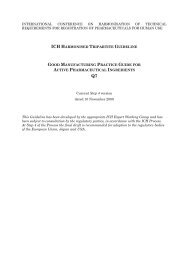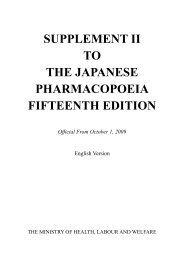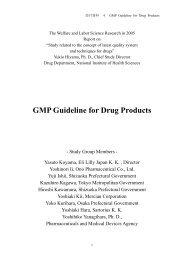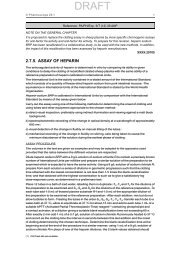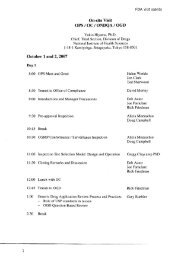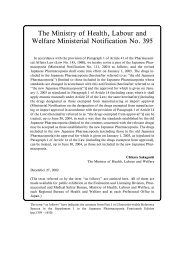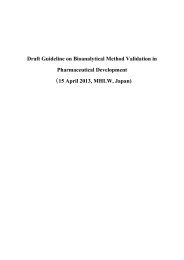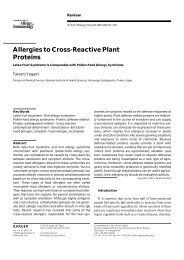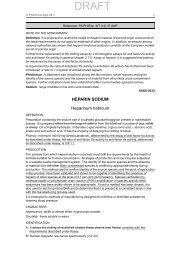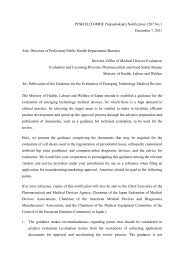ICH Q10 Pharmaceutical Quality System
ICH Q10 Pharmaceutical Quality System
ICH Q10 Pharmaceutical Quality System
Create successful ePaper yourself
Turn your PDF publications into a flip-book with our unique Google optimized e-Paper software.
<strong>Pharmaceutical</strong> <strong>Quality</strong> <strong>System</strong><strong>Q10</strong>Document HistoryCode History Date<strong>Q10</strong>Approval by the Steering Committee under Step 2 and releasefor public consultation.Current Step 4 version9 May2007<strong>Q10</strong>Approval by the Steering Committee under Step 4 andrecommendation for adoption to the three <strong>ICH</strong> regulatorybodies.4 June2008
<strong>Pharmaceutical</strong> <strong>Quality</strong> <strong>System</strong>3. CONTINUAL IMPROVEMENT OF PROCESS PERFORMANCE ANDPRODUCT QUALITY..............................................................................................73.1 Lifecycle Stage Goals .................................................................................................73.1.1 <strong>Pharmaceutical</strong> Development.........................................................................73.1.2 Technology Transfer .......................................................................................73.1.3 Commercial Manufacturing...........................................................................73.1.4 Product Discontinuation ................................................................................73.2 <strong>Pharmaceutical</strong> <strong>Quality</strong> <strong>System</strong> Elements...............................................................73.2.1 Process Performance and Product <strong>Quality</strong> Monitoring <strong>System</strong>....................83.2.2 Corrective Action and Preventive Action (CAPA) <strong>System</strong> .............................93.2.3 Change Management <strong>System</strong> .......................................................................103.2.4 Management Review of Process Performance and Product <strong>Quality</strong>..........114. CONTINUAL IMPROVEMENT OF THE PHARMACEUTICAL QUALITYSYSTEM ..................................................................................................................114.1 Management Review of the <strong>Pharmaceutical</strong> <strong>Quality</strong> <strong>System</strong> ...............................114.2 Monitoring of Internal and External Factors Impacting the <strong>Pharmaceutical</strong><strong>Quality</strong> <strong>System</strong>.........................................................................................................124.3 Outcomes of Management Review and Monitoring ...............................................125. GLOSSARY .............................................................................................................13Annex 1:Potential Opportunities to Enhance Science and Risk Based RegulatoryApproaches .............................................................................................................16Annex 2:Diagram of the <strong>ICH</strong> <strong>Q10</strong> <strong>Pharmaceutical</strong> <strong>Quality</strong> <strong>System</strong> Model .......................17ii
PHARMACEUTICAL QUALITY SYSTEM1. PHARMACEUTICAL QUALITY SYSTEM1.1 IntroductionThis document establishes a new <strong>ICH</strong> tripartite guideline describing a model for aneffective quality management system for the pharmaceutical industry, referred to asthe <strong>Pharmaceutical</strong> <strong>Quality</strong> <strong>System</strong>. Throughout this guideline, the term“pharmaceutical quality system” refers to the <strong>ICH</strong> <strong>Q10</strong> model.<strong>ICH</strong> <strong>Q10</strong> describes one comprehensive model for an effective pharmaceutical qualitysystem that is based on International Standards Organisation (ISO) quality concepts,includes applicable Good Manufacturing Practice (GMP) regulations and complements<strong>ICH</strong> Q8 “<strong>Pharmaceutical</strong> Development” and <strong>ICH</strong> Q9 “<strong>Quality</strong> Risk Management”. <strong>ICH</strong><strong>Q10</strong> is a model for a pharmaceutical quality system that can be implementedthroughout the different stages of a product lifecycle. Much of the content of <strong>ICH</strong> <strong>Q10</strong>applicable to manufacturing sites is currently specified by regional GMPrequirements. <strong>ICH</strong> <strong>Q10</strong> is not intended to create any new expectations beyond currentregulatory requirements. Consequently, the content of <strong>ICH</strong> <strong>Q10</strong> that is additional tocurrent regional GMP requirements is optional.<strong>ICH</strong> <strong>Q10</strong> demonstrates industry and regulatory authorities’ support of an effectivepharmaceutical quality system to enhance the quality and availability of medicinesaround the world in the interest of public health. Implementation of <strong>ICH</strong> <strong>Q10</strong>throughout the product lifecycle should facilitate innovation and continualimprovement and strengthen the link between pharmaceutical development andmanufacturing activities.1.2 ScopeThis guideline applies to the systems supporting the development and manufacture ofpharmaceutical drug substances (i.e., API) and drug products, including biotechnologyand biological products, throughout the product lifecycle.The elements of <strong>ICH</strong> <strong>Q10</strong> should be applied in a manner that is appropriate andproportionate to each of the product lifecycle stages, recognising the differencesamong, and the different goals of each stage (see Section 3).For the purposes of this guideline, the product lifecycle includes the followingtechnical activities for new and existing products:• <strong>Pharmaceutical</strong> Development:o Drug substance development;o Formulation development (including container/closure system);o Manufacture of investigational products;o Delivery system development (where relevant);o Manufacturing process development and scale-up;o Analytical method development.• Technology Transfer:o New product transfers during Development through Manufacturing;o Transfers within or between manufacturing and testing sites formarketed products.1
<strong>Pharmaceutical</strong> <strong>Quality</strong> <strong>System</strong>• Commercial Manufacturing:o Acquisition and control of materials;o Provision of facilities, utilities, and equipment;o Production (including packaging and labelling);o <strong>Quality</strong> control and assurance;o Release;o Storage;o Distribution (excluding wholesaler activities).• Product Discontinuation:o Retention of documentation;o Sample retention;o Continued product assessment and reporting.1.3 Relationship of <strong>ICH</strong> <strong>Q10</strong> to Regional GMP Requirements, ISOStandards and <strong>ICH</strong> Q7Regional GMP requirements, the <strong>ICH</strong> Q7 Guideline, “Good Manufacturing PracticeGuide for Active <strong>Pharmaceutical</strong> Ingredients”, and ISO quality management systemguidelines form the foundation for <strong>ICH</strong> <strong>Q10</strong>. To meet the objectives described below,<strong>ICH</strong> <strong>Q10</strong> augments GMPs by describing specific quality system elements andmanagement responsibilities. <strong>ICH</strong> <strong>Q10</strong> provides a harmonised model for apharmaceutical quality system throughout the lifecycle of a product and is intended tobe used together with regional GMP requirements.The regional GMPs do not explicitly address all stages of the product lifecycle (e.g.,Development). The quality system elements and management responsibilitiesdescribed in this guideline are intended to encourage the use of science and risk basedapproaches at each lifecycle stage, thereby promoting continual improvement acrossthe entire product lifecycle.1.4 Relationship of <strong>ICH</strong> <strong>Q10</strong> to Regulatory ApproachesRegulatory approaches for a specific product or manufacturing facility should becommensurate with the level of product and process understanding, the results ofquality risk management, and the effectiveness of the pharmaceutical quality system.When implemented, the effectiveness of the pharmaceutical quality system cannormally be evaluated during a regulatory inspection at the manufacturing site.Potential opportunities to enhance science and risk based regulatory approaches areidentified in Annex 1. Regulatory processes will be determined by region.1.5 <strong>ICH</strong> <strong>Q10</strong> ObjectivesImplementation of the <strong>Q10</strong> model should result in achievement of three mainobjectives which complement or enhance regional GMP requirements.1.5.1 Achieve Product RealisationTo establish, implement and maintain a system that allows the delivery of productswith the quality attributes appropriate to meet the needs of patients, health careprofessionals, regulatory authorities (including compliance with approved regulatoryfilings) and other internal and external customers.2
<strong>Pharmaceutical</strong> <strong>Quality</strong> <strong>System</strong>1.5.2 Establish and Maintain a State of ControlTo develop and use effective monitoring and control systems for process performanceand product quality, thereby providing assurance of continued suitability andcapability of processes. <strong>Quality</strong> risk management can be useful in identifying themonitoring and control systems.1.5.3 Facilitate Continual ImprovementTo identify and implement appropriate product quality improvements, processimprovements, variability reduction, innovations and pharmaceutical quality systemenhancements, thereby increasing the ability to fulfil quality needs consistently.<strong>Quality</strong> risk management can be useful for identifying and prioritising areas forcontinual improvement.1.6 Enablers: Knowledge Management and <strong>Quality</strong> Risk ManagementUse of knowledge management and quality risk management will enable a company toimplement <strong>ICH</strong> <strong>Q10</strong> effectively and successfully. These enablers will facilitateachievement of the objectives described in Section 1.5 above by providing the meansfor science and risk based decisions related to product quality.1.6.1 Knowledge ManagementProduct and process knowledge should be managed from development through thecommercial life of the product up to and including product discontinuation. Forexample, development activities using scientific approaches provide knowledge forproduct and process understanding. Knowledge management is a systematic approachto acquiring, analysing, storing and disseminating information related to products,manufacturing processes and components. Sources of knowledge include, but are notlimited to prior knowledge (public domain or internally documented); pharmaceuticaldevelopment studies; technology transfer activities; process validation studies overthe product lifecycle; manufacturing experience; innovation; continual improvement;and change management activities.1.6.2 <strong>Quality</strong> Risk Management<strong>Quality</strong> risk management is integral to an effective pharmaceutical quality system. Itcan provide a proactive approach to identifying, scientifically evaluating andcontrolling potential risks to quality. It facilitates continual improvement of processperformance and product quality throughout the product lifecycle. <strong>ICH</strong> Q9 providesprinciples and examples of tools for quality risk management that can be applied todifferent aspects of pharmaceutical quality.1.7 Design and Content Considerations(a) The design, organisation and documentation of the pharmaceutical qualitysystem should be well structured and clear to facilitate common understandingand consistent application.(b) The elements of <strong>ICH</strong> <strong>Q10</strong> should be applied in a manner that is appropriateand proportionate to each of the product lifecycle stages, recognising thedifferent goals and knowledge available for each stage.(c) The size and complexity of the company’s activities should be taken intoconsideration when developing a new pharmaceutical quality system or3
<strong>Pharmaceutical</strong> <strong>Quality</strong> <strong>System</strong>system and ensure its implementation throughout their organisation;(3) Ensure a timely and effective communication and escalation processexists to raise quality issues to the appropriate levels of management;(4) Define individual and collective roles, responsibilities, authorities andinter-relationships of all organisational units related to thepharmaceutical quality system. Ensure these interactions arecommunicated and understood at all levels of the organisation. Anindependent quality unit/structure with authority to fulfil certainpharmaceutical quality system responsibilities is required by regionalregulations;(5) Conduct management reviews of process performance and productquality and of the pharmaceutical quality system;(6) Advocate continual improvement;(7) Commit appropriate resources.2.2 <strong>Quality</strong> Policy(a) Senior management should establish a quality policy that describes the overallintentions and direction of the company related to quality.(b) The quality policy should include an expectation to comply with applicableregulatory requirements and should facilitate continual improvement of thepharmaceutical quality system.(c) The quality policy should be communicated to and understood by personnel atall levels in the company.(d) The quality policy should be reviewed periodically for continuing effectiveness.2.3 <strong>Quality</strong> Planning(a) Senior management should ensure the quality objectives needed to implementthe quality policy are defined and communicated.(b) <strong>Quality</strong> objectives should be supported by all relevant levels of the company.(c) <strong>Quality</strong> objectives should align with the company’s strategies and be consistentwith the quality policy.(d) Management should provide the appropriate resources and training to achievethe quality objectives.(e) Performance indicators that measure progress against quality objectivesshould be established, monitored, communicated regularly and acted upon asappropriate as described in Section 4.1 of this document.2.4 Resource Management(a) Management should determine and provide adequate and appropriateresources (human, financial, materials, facilities and equipment) to implementand maintain the pharmaceutical quality system and continually improve itseffectiveness.(b) Management should ensure that resources are appropriately applied to a5
<strong>Pharmaceutical</strong> <strong>Quality</strong> <strong>System</strong>specific product, process or site.2.5 Internal Communication(a) Management should ensure appropriate communication processes areestablished and implemented within the organisation.(b) Communications processes should ensure the flow of appropriate informationbetween all levels of the company.(c) Communication processes should ensure the appropriate and timely escalationof certain product quality and pharmaceutical quality system issues.2.6 Management Review(a) Senior management should be responsible for pharmaceutical quality systemgovernance through management review to ensure its continuing suitabilityand effectiveness.(b) Management should assess the conclusions of periodic reviews of processperformance and product quality and of the pharmaceutical quality system, asdescribed in Sections 3 and 4.2.7 Management of Outsourced Activities and Purchased MaterialsThe pharmaceutical quality system, including the management responsibilitiesdescribed in this section, extends to the control and review of any outsourced activitiesand quality of purchased materials. The pharmaceutical company is ultimatelyresponsible to ensure processes are in place to assure the control of outsourcedactivities and quality of purchased materials. These processes should incorporatequality risk management and include:(a) Assessing prior to outsourcing operations or selecting material suppliers, thesuitability and competence of the other party to carry out the activity orprovide the material using a defined supply chain (e.g., audits, materialevaluations, qualification);(b) Defining the responsibilities and communication processes for quality-relatedactivities of the involved parties. For outsourced activities, this should beincluded in a written agreement between the contract giver and contractacceptor;(c) Monitoring and review of the performance of the contract acceptor or thequality of the material from the provider, and the identification andimplementation of any needed improvements;(d) Monitoring incoming ingredients and materials to ensure they are fromapproved sources using the agreed supply chain.2.8 Management of Change in Product OwnershipWhen product ownership changes, (e.g., through acquisitions) management shouldconsider the complexity of this and ensure:(a) The ongoing responsibilities are defined for each company involved;6
<strong>Pharmaceutical</strong> <strong>Quality</strong> <strong>System</strong>(b) The necessary information is transferred.3. CONTINUAL IMPROVEMENT OF PROCESS PERFORMANCE ANDPRODUCT QUALITYThis section describes the lifecycle stage goals and the four specific pharmaceuticalquality system elements that augment regional requirements to achieve the <strong>ICH</strong> <strong>Q10</strong>objectives, as defined in Section 1.5. It does not restate all regional GMPrequirements.3.1 Lifecycle Stage GoalsThe goals of each product lifecycle stage are described below.3.1.1 <strong>Pharmaceutical</strong> DevelopmentThe goal of pharmaceutical development activities is to design a product and itsmanufacturing process to consistently deliver the intended performance and meet theneeds of patients and healthcare professionals, and regulatory authorities andinternal customers’ requirements. Approaches to pharmaceutical development aredescribed in <strong>ICH</strong> Q8. The results of exploratory and clinical development studies,while outside the scope of this guidance, are inputs to pharmaceutical development.3.1.2 Technology TransferThe goal of technology transfer activities is to transfer product and process knowledgebetween development and manufacturing, and within or between manufacturing sitesto achieve product realisation. This knowledge forms the basis for the manufacturingprocess, control strategy, process validation approach and ongoing continualimprovement.3.1.3 Commercial ManufacturingThe goals of manufacturing activities include achieving product realisation,establishing and maintaining a state of control and facilitating continualimprovement. The pharmaceutical quality system should assure that the desiredproduct quality is routinely met, suitable process performance is achieved, the set ofcontrols are appropriate, improvement opportunities are identified and evaluated, andthe body of knowledge is continually expanded.3.1.4 Product DiscontinuationThe goal of product discontinuation activities is to manage the terminal stage of theproduct lifecycle effectively. For product discontinuation, a pre-defined approachshould be used to manage activities such as retention of documentation and samplesand continued product assessment (e.g., complaint handling and stability) andreporting in accordance with regulatory requirements.3.2 <strong>Pharmaceutical</strong> <strong>Quality</strong> <strong>System</strong> ElementsThe elements described below might be, required in part under regional GMPregulations. However, the <strong>Q10</strong> model’s intent is to enhance these elements in order topromote the lifecycle approach to product quality. These four elements are:• Process performance and product quality monitoring system;• Corrective action and preventive action (CAPA) system;• Change management system;7
<strong>Pharmaceutical</strong> <strong>Quality</strong> <strong>System</strong>• Management review of process performance and product quality.These elements should be applied in a manner that is appropriate and proportionateto each of the product lifecycle stages, recognising the differences among, and thedifferent goals of, each stage. Throughout the product lifecycle, companies areencouraged to evaluate opportunities for innovative approaches to improve productquality.Each element is followed by a table of example applications of the element to thestages of the pharmaceutical lifecycle.3.2.1 Process Performance and Product <strong>Quality</strong> Monitoring <strong>System</strong><strong>Pharmaceutical</strong> companies should plan and execute a system for the monitoring ofprocess performance and product quality to ensure a state of control is maintained. Aneffective monitoring system provides assurance of the continued capability ofprocesses and controls to produce a product of desired quality and to identify areas forcontinual improvement. The process performance and product quality monitoringsystem should:(a) Use quality risk management to establish the control strategy. This caninclude parameters and attributes related to drug substance and drug productmaterials and components, facility and equipment operating conditions, inprocesscontrols, finished product specifications, and the associated methodsand frequency of monitoring and control. The control strategy should facilitatetimely feedback / feedforward and appropriate corrective action and preventiveaction;(b) Provide the tools for measurement and analysis of parameters and attributesidentified in the control strategy (e.g., data management and statistical tools);(c) Analyse parameters and attributes identified in the control strategy to verifycontinued operation within a state of control;(d) Identify sources of variation affecting process performance and product qualityfor potential continual improvement activities to reduce or control variation;(e) Include feedback on product quality from both internal and external sources,e.g., complaints, product rejections, non-conformances, recalls, deviations,audits and regulatory inspections and findings;(f) Provide knowledge to enhance process understanding, enrich the design space(where established), and enable innovative approaches to process validation.8
<strong>Pharmaceutical</strong> <strong>Quality</strong> <strong>System</strong>Table I: Application of Process Performance and Product <strong>Quality</strong>Monitoring <strong>System</strong> throughout the Product Lifecycle<strong>Pharmaceutical</strong>DevelopmentTechnologyTransferCommercialManufacturingProductDiscontinuationProcess and productknowledge generatedand process andproduct monitoringconducted throughoutdevelopment can beused to establish acontrol strategy formanufacturing.Monitoring duringscale-up activities canprovide a preliminaryindication of processperformance and thesuccessful integrationinto manufacturing.Knowledge obtainedduring transfer andscale up activities canbe useful in furtherdeveloping the controlstrategy.A well-defined systemfor processperformance andproduct qualitymonitoring should beapplied to assureperformance within astate of control and toidentify improvementareas.Once manufacturingceases, monitoringsuch as stabilitytesting shouldcontinue tocompletion of thestudies. Appropriateaction on marketedproduct shouldcontinue to beexecuted according toregional regulations.3.2.2 Corrective Action and Preventive Action (CAPA) <strong>System</strong>The pharmaceutical company should have a system for implementing correctiveactions and preventive actions resulting from the investigation of complaints, productrejections, non-conformances, recalls, deviations, audits, regulatory inspections andfindings, and trends from process performance and product quality monitoring. Astructured approach to the investigation process should be used with the objective ofdetermining the root cause. The level of effort, formality, and documentation of theinvestigation should be commensurate with the level of risk, in line with <strong>ICH</strong> Q9.CAPA methodology should result in product and process improvements and enhancedproduct and process understanding.Table II: Application of Corrective Action and Preventive Action <strong>System</strong>throughout the Product Lifecycle<strong>Pharmaceutical</strong>DevelopmentTechnologyTransferCommercialManufacturingProductDiscontinuationProduct or processvariability is explored.CAPA methodology isuseful where correctiveactions and preventiveactions areincorporated into theiterative design anddevelopment process.CAPA can be used asan effective system forfeedback, feedforwardand continualimprovement.CAPA should be usedand the effectivenessof the actions shouldbe evaluated.CAPA shouldcontinue after theproduct isdiscontinued. Theimpact on productremaining on themarket should beconsidered as well asother products whichmight be impacted.9
<strong>Pharmaceutical</strong> <strong>Quality</strong> <strong>System</strong>3.2.3 Change Management <strong>System</strong>Innovation, continual improvement, the outputs of process performance and productquality monitoring and CAPA drive change. In order to evaluate, approve andimplement these changes properly, a company should have an effective changemanagement system. There is generally a difference in formality of changemanagement processes prior to the initial regulatory submission and aftersubmission, where changes to the regulatory filing might be required under regionalrequirements.The change management system ensures continual improvement is undertaken in atimely and effective manner. It should provide a high degree of assurance there are nounintended consequences of the change.The change management system should include the following, as appropriate for thestage of the lifecycle:(a) <strong>Quality</strong> risk management should be utilised to evaluate proposed changes. Thelevel of effort and formality of the evaluation should be commensurate with thelevel of risk;(b) Proposed changes should be evaluated relative to the marketing authorisation,including design space, where established, and/or current product and processunderstanding. There should be an assessment to determine whether a changeto the regulatory filing is required under regional requirements. As stated in<strong>ICH</strong> Q8, working within the design space is not considered a change (from aregulatory filing perspective). However, from a pharmaceutical quality systemstandpoint, all changes should be evaluated by a company’s changemanagement system;(c) Proposed changes should be evaluated by expert teams contributing theappropriate expertise and knowledge from relevant areas (e.g., <strong>Pharmaceutical</strong>Development, Manufacturing, <strong>Quality</strong>, Regulatory Affairs and Medical), toensure the change is technically justified. Prospective evaluation criteria for aproposed change should be set;(d) After implementation, an evaluation of the change should be undertaken toconfirm the change objectives were achieved and that there was no deleteriousimpact on product quality.Table III: Application of Change Management <strong>System</strong> throughout theProduct Lifecycle<strong>Pharmaceutical</strong>DevelopmentChange is an inherentpart of the developmentprocess and should bedocumented; theformality of the changemanagement processshould be consistentwith the stage ofpharmaceuticaldevelopment.TechnologyTransferThe changemanagement systemshould providemanagement anddocumentation ofadjustments made tothe process duringtechnology transferactivities.CommercialManufacturingA formal changemanagement systemshould be in place forcommercialmanufacturing.Oversight by thequality unit shouldprovide assurance ofappropriate scienceand risk basedassessments.ProductDiscontinuationAny changes afterproductdiscontinuationshould go through anappropriate changemanagement system.10
<strong>Pharmaceutical</strong> <strong>Quality</strong> <strong>System</strong>3.2.4 Management Review of Process Performance and Product <strong>Quality</strong>Management review should provide assurance that process performance and productquality are managed over the lifecycle. Depending on the size and complexity of thecompany, management review can be a series of reviews at various levels ofmanagement and should include a timely and effective communication and escalationprocess to raise appropriate quality issues to senior levels of management for review.(a) The management review system should include:(1) The results of regulatory inspections and findings, audits and otherassessments, and commitments made to regulatory authorities;(2) Periodic quality reviews, that can include:(i) Measures of customer satisfaction such as product qualitycomplaints and recalls;(ii) Conclusions of process performance and product qualitymonitoring;(iii)The effectiveness of process and product changes including thosearising from corrective action and preventive actions.(3) Any follow-up actions from previous management reviews.(b) The management review system should identify appropriate actions, such as:(1) Improvements to manufacturing processes and products;(2) Provision, training and/or realignment of resources;(3) Capture and dissemination of knowledge.Table IV: Application of Management Review of Process Performance andProduct <strong>Quality</strong> throughout the Product Lifecycle<strong>Pharmaceutical</strong>DevelopmentTechnologyTransferCommercialManufacturingProductDiscontinuationAspects ofmanagement reviewcan be performed toensure adequacy ofthe product andprocess design.Aspects ofmanagement reviewshould be performedto ensure thedeveloped product andprocess can bemanufactured atcommercial scale.Management reviewshould be a structuredsystem, as describedabove, and shouldsupport continualimprovement.Management reviewshould include suchitems as productstability and productquality complaints.4. CONTINUAL IMPROVEMENT OF THE PHARMACEUTICAL QUALITYSYSTEMThis section describes activities that should be conducted to manage and continuallyimprove the pharmaceutical quality system.4.1 Management Review of the <strong>Pharmaceutical</strong> <strong>Quality</strong> <strong>System</strong>Management should have a formal process for reviewing the pharmaceutical qualitysystem on a periodic basis. The review should include:(a) Measurement of achievement of pharmaceutical quality system objectives;(b) Assessment of performance indicators that can be used to monitor the11
<strong>Pharmaceutical</strong> <strong>Quality</strong> <strong>System</strong>effectiveness of processes within the pharmaceutical quality system, such as:(1) Complaint, deviation, CAPA and change management processes;(2) Feedback on outsourced activities;(3) Self-assessment processes including risk assessments, trending, andaudits;(4) External assessments such as regulatory inspections and findings andcustomer audits.4.2 Monitoring of Internal and External Factors Impacting the<strong>Pharmaceutical</strong> <strong>Quality</strong> <strong>System</strong>Factors monitored by management can include:(a) Emerging regulations, guidance and quality issues that can impact the<strong>Pharmaceutical</strong> <strong>Quality</strong> <strong>System</strong>;(b) Innovations that might enhance the pharmaceutical quality system;(c) Changes in business environment and objectives;(d) Changes in product ownership.4.3 Outcomes of Management Review and MonitoringThe outcome of management review of the pharmaceutical quality system andmonitoring of internal and external factors can include:(e) Improvements to the pharmaceutical quality system and related processes;(f) Allocation or reallocation of resources and/or personnel training;(g) Revisions to quality policy and quality objectives;(h) Documentation and timely and effective communication of the results of themanagement review and actions, including escalation of appropriate issues tosenior management.12
<strong>Pharmaceutical</strong> <strong>Quality</strong> <strong>System</strong>5. GLOSSARY<strong>ICH</strong> and ISO definitions are used in <strong>ICH</strong> <strong>Q10</strong> where they exist. For the purpose of<strong>ICH</strong> <strong>Q10</strong>, where the words “requirement”, “requirements” or “necessary” appear in anISO definition, they do not necessarily reflect a regulatory requirement. The source ofthe definition is identified in parentheses after the definition. Where no appropriate<strong>ICH</strong> or ISO definition was available, an <strong>ICH</strong> <strong>Q10</strong> definition was developed.Capability of a Process:Ability of a process to realise a product that will fulfil the requirements of thatproduct. The concept of process capability can also be defined in statistical terms. (ISO9000:2005)Change Management:A systematic approach to proposing, evaluating, approving, implementing andreviewing changes. (<strong>ICH</strong> <strong>Q10</strong>)Continual Improvement:Recurring activity to increase the ability to fulfil requirements. (ISO 9000:2005)Control Strategy:A planned set of controls, derived from current product and process understanding,that assures process performance and product quality. The controls can includeparameters and attributes related to drug substance and drug product materials andcomponents, facility and equipment operating conditions, in-process controls, finishedproduct specifications, and the associated methods and frequency of monitoring andcontrol. (<strong>ICH</strong> <strong>Q10</strong>)Corrective Action:Action to eliminate the cause of a detected non-conformity or other undesirablesituation. NOTE: Corrective action is taken to prevent recurrence whereas preventiveaction is taken to prevent occurrence. (ISO 9000:2005)Design Space:The multidimensional combination and interaction of input variables (e.g., materialattributes) and process parameters that have been demonstrated to provide assuranceof quality. (<strong>ICH</strong> Q8)Enabler:A tool or process which provides the means to achieve an objective. (<strong>ICH</strong> <strong>Q10</strong>)Feedback / Feedforward:Feedback: The modification or control of a process or system by its results or effects.Feedforward: The modification or control of a process using its anticipated results oreffects. (Oxford Dictionary of English. Oxford University Press; 2003)Feedback/ feedforward can be applied technically in process control strategies andconceptually in quality management. (<strong>ICH</strong> <strong>Q10</strong>)Innovation:The introduction of new technologies or methodologies. (<strong>ICH</strong> <strong>Q10</strong>)13
<strong>Pharmaceutical</strong> <strong>Quality</strong> <strong>System</strong>Knowledge Management:<strong>System</strong>atic approach to acquiring, analysing, storing, and disseminating informationrelated to products, manufacturing processes and components. (<strong>ICH</strong> <strong>Q10</strong>)Outsourced Activities:Activities conducted by a contract acceptor under a written agreement with a contractgiver. (<strong>ICH</strong> <strong>Q10</strong>)Performance Indicators:Measurable values used to quantify quality objectives to reflect the performance of anorganisation, process or system, also known as “performance metrics” in some regions.(<strong>ICH</strong> <strong>Q10</strong>)<strong>Pharmaceutical</strong> <strong>Quality</strong> <strong>System</strong> (PQS):Management system to direct and control a pharmaceutical company with regard toquality. (<strong>ICH</strong> <strong>Q10</strong> based upon ISO 9000:2005)Preventive Action:Action to eliminate the cause of a potential non-conformity or other undesirablepotential situation. NOTE: Preventive action is taken to prevent occurrence whereascorrective action is taken to prevent recurrence. (ISO 9000:2005)Product Realisation:Achievement of a product with the quality attributes appropriate to meet the needs ofpatients, health care professionals, and regulatory authorities (including compliancewith marketing authorisation) and internal customers requirements. (<strong>ICH</strong> <strong>Q10</strong>)<strong>Quality</strong>:The degree to which a set of inherent properties of a product, system or process fulfilsrequirements. (<strong>ICH</strong> Q9)<strong>Quality</strong> Manual:Document specifying the quality management system of an organisation. (ISO9000:2005)<strong>Quality</strong> Objectives:A means to translate the quality policy and strategies into measurable activities. (<strong>ICH</strong><strong>Q10</strong>)<strong>Quality</strong> Planning:Part of quality management focused on setting quality objectives and specifyingnecessary operational processes and related resources to fulfil the quality objectives.(ISO 9000:2005)<strong>Quality</strong> Policy:Overall intentions and direction of an organisation related to quality as formallyexpressed by senior management. (ISO 9000:2005)<strong>Quality</strong> Risk Management:A systematic process for the assessment, control, communication and review of risksto the quality of the drug (medicinal) product across the product lifecycle. (<strong>ICH</strong> Q9)14
<strong>Pharmaceutical</strong> <strong>Quality</strong> <strong>System</strong>Annex 1Potential Opportunities to Enhance Science and Risk Based RegulatoryApproaches **Note: This annex reflects potential opportunities to enhance regulatory approaches.The actual regulatory process will be determined by region.ScenarioPotential Opportunity1. Comply with GMPs Compliance – status quo2. Demonstrate effectivepharmaceutical quality system,including effective use of qualityrisk management principles (e.g.,<strong>ICH</strong> Q9 and <strong>ICH</strong> <strong>Q10</strong>).3. Demonstrate product and processunderstanding, including effectiveuse of quality risk managementprinciples (e.g., <strong>ICH</strong> Q8 and <strong>ICH</strong>Q9).4. Demonstrate effectivepharmaceutical quality systemand product and processunderstanding, including the useof quality risk managementprinciples (e.g., <strong>ICH</strong> Q8, <strong>ICH</strong> Q9and <strong>ICH</strong> <strong>Q10</strong>).Opportunity to:• increase use of risk basedapproaches for regulatoryinspections.Opportunity to:• facilitate science basedpharmaceutical qualityassessment;• enable innovative approaches toprocess validation;• establish real-time releasemechanisms.Opportunity to:• increase use of risk basedapproaches for regulatoryinspections;• facilitate science basedpharmaceutical qualityassessment;• optimise science and risk basedpost-approval change processes tomaximise benefits from innovationand continual improvement;• enable innovative approaches toprocess validation;• establish real-time releasemechanisms.16
<strong>Pharmaceutical</strong> <strong>Quality</strong> <strong>System</strong>Annex 2Diagram of the <strong>ICH</strong> <strong>Q10</strong> <strong>Pharmaceutical</strong> <strong>Quality</strong> <strong>System</strong> ModelThis diagram illustrates the major features of the <strong>ICH</strong> <strong>Q10</strong> <strong>Pharmaceutical</strong> <strong>Quality</strong><strong>System</strong> (PQS) model. The PQS covers the entire lifecycle of a product includingpharmaceutical development, technology transfer, commercial manufacturing, andproduct discontinuation as illustrated by the upper portion of the diagram. The PQSaugments regional GMPs as illustrated in the diagram. The diagram also illustratesthat regional GMPs apply to the manufacture of investigational products.The next horizontal bar illustrates the importance of management responsibilitiesexplained in Section 2 to all stages of the product lifecycle. The following horizontalbar lists the PQS elements which serve as the major pillars under the PQS model.These elements should be applied appropriately and proportionally to each lifecyclestage recognising opportunities to identify areas for continual improvement.The bottom set of horizontal bars illustrates the enablers: knowledge managementand quality risk management, which are applicable throughout the lifecycle stages.These enablers support the PQS goals of achieving product realisation, establishingand maintaining a state of control, and facilitating continual improvement.17



